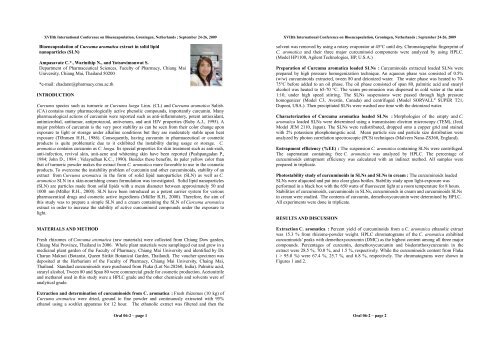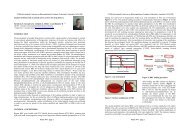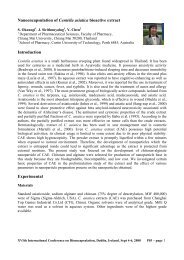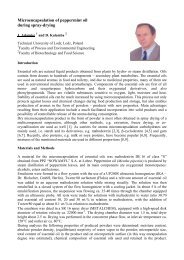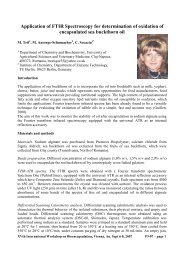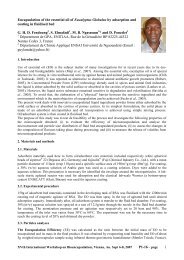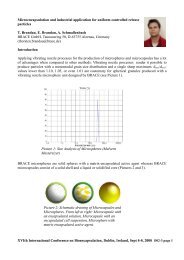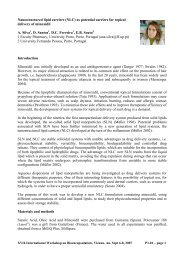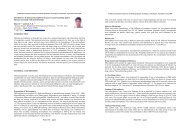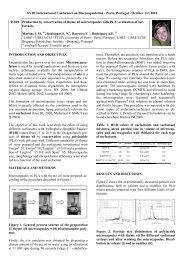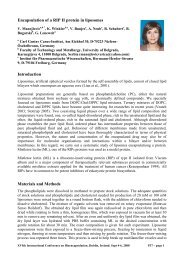Bioencapsulation of Curcuma aromatica extract in solid lipid ...
Bioencapsulation of Curcuma aromatica extract in solid lipid ...
Bioencapsulation of Curcuma aromatica extract in solid lipid ...
You also want an ePaper? Increase the reach of your titles
YUMPU automatically turns print PDFs into web optimized ePapers that Google loves.
XVIIth International Conference on <strong>Bioencapsulation</strong>, Gron<strong>in</strong>gen, Netherlands ; September 24-26, 2009<br />
<strong>Bioencapsulation</strong> <strong>of</strong> <strong>Curcuma</strong> <strong>aromatica</strong> <strong>extract</strong> <strong>in</strong> <strong>solid</strong> <strong>lipid</strong><br />
nanoparticles (SLN)<br />
Ampasavate C.* , War<strong>in</strong>thip N., and Yotsawimonwat S.<br />
Department <strong>of</strong> Pharmaceutical Sciences, Faculty <strong>of</strong> Pharmacy, Chiang Mai<br />
University, Chiang Mai, Thailand 50200<br />
*e-mail: chadarat@pharmacy.cmu.ac.th<br />
INTRODUCTION<br />
<strong>Curcuma</strong> species such as turmeric or <strong>Curcuma</strong> longa L<strong>in</strong>n. (CL) and <strong>Curcuma</strong> <strong>aromatica</strong> Salisb.<br />
(CA) conta<strong>in</strong>s many pharmacologically active phenolic compounds, importantly curcum<strong>in</strong>. Many<br />
pharmacological actions <strong>of</strong> curcum<strong>in</strong> were reported such as anti-<strong>in</strong>flammatory, potent antioxidant,<br />
antimicrobial, antitumor, antiprotozoal, antivenom, and anti HIV properties (Ruby A.J., 1995). A<br />
major problem <strong>of</strong> curcum<strong>in</strong> is the very poor stability as can be seen from their color change upon<br />
exposure to light or storage under alkal<strong>in</strong>e conditions but they are moderately stable upon heat<br />
exposure (TØnnsen H.H., 1986). Consequently, hav<strong>in</strong>g curcum<strong>in</strong> <strong>in</strong> pharmaceutical or cosmetic<br />
products is quite problematic due to it exhibited the <strong>in</strong>stability dur<strong>in</strong>g usage or storage. C.<br />
<strong>aromatica</strong> conta<strong>in</strong>s curcum<strong>in</strong> as C. longa. Its special properties for sk<strong>in</strong> treatment such as anti-rash,<br />
anti-<strong>in</strong>fection, revival sk<strong>in</strong>, anti-acne and whiten<strong>in</strong>g sk<strong>in</strong> have been reported (Pushpangadan P.,<br />
1984; John D., 1984 ; Velayudhan K.C., 1990). Besides these benefits, its paler yellow color than<br />
that <strong>of</strong> turmeric powder makes the <strong>extract</strong> from C. <strong>aromatica</strong> more favorable to use <strong>in</strong> the cosmetic<br />
products. To overcome the <strong>in</strong>stability problem <strong>of</strong> curcum<strong>in</strong> and other curcum<strong>in</strong>oids, stability <strong>of</strong> an<br />
<strong>extract</strong> from <strong>Curcuma</strong> <strong>aromatica</strong> <strong>in</strong> the form <strong>of</strong> <strong>solid</strong> <strong>lipid</strong> nanoparticles (SLN) as well as C.<br />
<strong>aromatica</strong> SLN <strong>in</strong> a sk<strong>in</strong>-nourish<strong>in</strong>g cream formulation was <strong>in</strong>vestigated. Solid <strong>lipid</strong> nanoparticles<br />
(SLN) are particles made from <strong>solid</strong> <strong>lipid</strong>s with a mean diameter between approximately 50 and<br />
1000 nm (Müller R.H., 2000). SLN have been <strong>in</strong>troduced as a potent carrier system for various<br />
pharmaceutical drugs and cosmetic active <strong>in</strong>gredients (Müller R.H., 2000). Therefore, the aim <strong>of</strong><br />
this study was to prepare a simple SLN and a cream conta<strong>in</strong><strong>in</strong>g the SLN <strong>of</strong> <strong>Curcuma</strong> <strong>aromatica</strong><br />
<strong>extract</strong> <strong>in</strong> order to <strong>in</strong>crease the stability <strong>of</strong> active curcum<strong>in</strong>oid compounds under the exposure to<br />
light.<br />
MATERIALS AND METHOD<br />
Fresh rhizomes <strong>of</strong> <strong>Curcuma</strong> <strong>aromatica</strong> (raw materials) were collected from Chiang Dow garden,<br />
Chiang Mai Prov<strong>in</strong>ce, Thailand <strong>in</strong> 2006. Whole plant materials were sampl<strong>in</strong>ged out and grew <strong>in</strong> a<br />
medic<strong>in</strong>al plant garden <strong>of</strong> the Faculty <strong>of</strong> Pharmacy, Chiang Mai University and identified by Dr.<br />
Charun Maknoi (Botanist, Queen Sirikit Botanical Garden, Thailand). The voucher specimen was<br />
deposited at the Herbarium <strong>of</strong> the Faculty <strong>of</strong> Pharmacy, Chiang Mai University, Cha<strong>in</strong>g Mai,<br />
Thailand. Standard curcum<strong>in</strong>oids were purchased from Fluka (Lot No.28260, India). Palmitic acid,<br />
stearyl alcohol, Tween 80 and Span 80 were commercial grade for cosmetic production. Acetonitrile<br />
and methanol used <strong>in</strong> this study were a HPLC grade and the other chemicals and solvents were <strong>of</strong><br />
analytical grade.<br />
XVIIth International Conference on <strong>Bioencapsulation</strong>, Gron<strong>in</strong>gen, Netherlands ; September 24-26, 2009<br />
solvent was removed by us<strong>in</strong>g a rotary evaporator at 45°C until dry. Chromatographic f<strong>in</strong>gerpr<strong>in</strong>t <strong>of</strong><br />
C. <strong>aromatica</strong> and their three major curcum<strong>in</strong>oid components were analyzed by us<strong>in</strong>g HPLC.<br />
(Model HP1100, Agilent Technologies, HP, U.S.A.)<br />
Preparation <strong>of</strong> <strong>Curcuma</strong> <strong>aromatica</strong> loaded SLNs : Curcum<strong>in</strong>oids <strong>extract</strong>ed loaded SLNs were<br />
prepared by high pressure homogenization technique. An aqueous phase was consisted <strong>of</strong> 0.5%<br />
(w/w) curcum<strong>in</strong>oids <strong>extract</strong>ed, tween 80 and deionized water. The water phase was heated to 70-<br />
75°C before added to an oil phase. The oil phase consisted <strong>of</strong> span 80, palmitic acid and stearyl<br />
alcohol was heated to 65-70 °C. The warm pre-emusion was dispersed <strong>in</strong> cold water at the ratio<br />
1:10, under high speed stirr<strong>in</strong>g. The SLNs suspensions were passed through high pressure<br />
homogenizer (Model C3, Avest<strong>in</strong>, Canada) and centrifuged (Model SORVALL ® SUPER T21,<br />
Dupont, USA.). Then precipitated SLNs were washed one time with the deionized water.<br />
Characterization <strong>of</strong> <strong>Curcuma</strong> <strong>aromatica</strong> loaded SLNs : Morphologies <strong>of</strong> the empty and C.<br />
<strong>aromatica</strong> loaded SLNs were determ<strong>in</strong>ed us<strong>in</strong>g a transmission electron microscopy (TEM), (Jeol,<br />
Model JEM 2110, Japan). The SLNs were redistributed, dropped onto a copper grid and sta<strong>in</strong>ed<br />
with 2% potassium phosphotungstic acid. Mean particle size and particle size distribution were<br />
analyzed by photon correlation spectroscopic (PCS) techniques (Malvern Nano-ZS360, England).<br />
Entrapment efficiency (%EE) : The suspension C. <strong>aromatica</strong> conta<strong>in</strong><strong>in</strong>g SLNs were centrifuged.<br />
The supernatant conta<strong>in</strong><strong>in</strong>g free C. <strong>aromatica</strong> was analyzed by HPLC. The percentage <strong>of</strong><br />
curcum<strong>in</strong>oids entrapment efficiency was calculated with an <strong>in</strong>direct method. All samples were<br />
prepared <strong>in</strong> triplicate.<br />
Photostability study <strong>of</strong> curcum<strong>in</strong>oids <strong>in</strong> SLNs and SLNs <strong>in</strong> cream : The curcum<strong>in</strong>oids loaded<br />
SLNs were aliquoted and put <strong>in</strong>to clear glass bottles. Stability study upon light-exposure was<br />
performed <strong>in</strong> a black box with the 650 watts <strong>of</strong> fluorescent light at a room temperature for 8 hours.<br />
Stabilities <strong>of</strong> curcum<strong>in</strong>oids, curcum<strong>in</strong>oids <strong>in</strong> SLNs, curcum<strong>in</strong>oids <strong>in</strong> cream and curcum<strong>in</strong>oids SLNs<br />
<strong>in</strong> cream were studied. The contents <strong>of</strong> curcum<strong>in</strong>, demethoxycurcum<strong>in</strong> were determ<strong>in</strong>ed by HPLC.<br />
All experiments were done <strong>in</strong> triplicate.<br />
RESULTS AND DISCUSSION<br />
Extraction C. <strong>aromatica</strong> : Percent yield <strong>of</strong> curcum<strong>in</strong>oids from a C. <strong>aromatica</strong> ethanolic <strong>extract</strong><br />
was 15.3 % from rhizome-powder weight. HPLC chromatograms <strong>of</strong> the C. <strong>aromatica</strong> exhibited<br />
curcum<strong>in</strong>oids’ peaks with demethoxycurcum<strong>in</strong> (DMC) as the highest content among all three major<br />
compounds. Percentages <strong>of</strong> curcum<strong>in</strong>, demethoxycurcum<strong>in</strong> and bisdemrthoxycurcum<strong>in</strong> <strong>in</strong> the<br />
<strong>extract</strong> were 28.5 %, 70.0 %, and 1.5 %, respectively. While the curcum<strong>in</strong>oids content from Fluka<br />
( > 95.0 %) were 67.4 %, 25.7 %, and 6.8 %, respectively. The chromatograms were shown <strong>in</strong><br />
Figures 1 and 2.<br />
Extraction and determ<strong>in</strong>ation <strong>of</strong> curcum<strong>in</strong>oids from C. <strong>aromatica</strong> : Fresh rhizomes (10 kg) <strong>of</strong><br />
<strong>Curcuma</strong> <strong>aromatica</strong> were dried, ground to f<strong>in</strong>e powder and cont<strong>in</strong>uously <strong>extract</strong>ed with 95%<br />
ethanol us<strong>in</strong>g a soxhlet apparatus for 12 hour. The ethanolic <strong>extract</strong> was filtered and then the<br />
Oral 06-2 – page 1<br />
Oral 06-2 – page 2
XVIIth International Conference on <strong>Bioencapsulation</strong>, Gron<strong>in</strong>gen, Netherlands ; September 24-26, 2009<br />
XVIIth International Conference on <strong>Bioencapsulation</strong>, Gron<strong>in</strong>gen, Netherlands ; September 24-26, 2009<br />
theSLNs could enhance their stability <strong>in</strong> both SLNs and <strong>in</strong> cream formulation significantly. Similar<br />
observation was revealed when the demethoxycurcum<strong>in</strong> contents were determ<strong>in</strong>ed (Fig 5 and 6).<br />
Fig.1. Chromatogram <strong>of</strong> curcum<strong>in</strong>oids<br />
from C. <strong>aromatica</strong>.<br />
Fig.2. Chromatogram <strong>of</strong> standard<br />
curcum<strong>in</strong>oids (Fluka)<br />
Preparation <strong>of</strong> C. <strong>aromatica</strong> loades SLNs and Entrapment efficiency (%EE) : C. <strong>aromatica</strong><br />
loaded SLNs were successfully prepared by high pressure homogenization technique. Firstly,<br />
C.<strong>aromatica</strong> <strong>extract</strong> was dispersed homogeneously <strong>in</strong> a melted <strong>lipid</strong> phase. High speed stirr<strong>in</strong>g was<br />
performed to obta<strong>in</strong> a pre-emulsion, which was subsequently dispersed <strong>in</strong> cold water prior to<br />
pass<strong>in</strong>g to a high pressure homogenizer. In order to select a suitable <strong>lipid</strong> for load<strong>in</strong>g the<br />
C.<strong>aromatica</strong> <strong>extract</strong> <strong>in</strong>to the SLNs, several <strong>lipid</strong>s such as palmitic acid, cetyl palmitate, cetyl<br />
alcohol and stearyl alcohol were employed at different ratios. The most suitable nanoparticles were<br />
derived from palmitic acid and stearyl alcohol mixture with appropriate amount <strong>of</strong> surfactants. The<br />
suspension <strong>of</strong> the prepared nanoparticles was concentrated by centrifugation. Then, the <strong>extract</strong><br />
loaded SLNs were added <strong>in</strong> a model cream base. Transmission electron micrographs (TEM)<br />
revealed that the shape <strong>of</strong> the C.<strong>aromatica</strong> <strong>extract</strong> unloaded and loaded SLNs were a spherical <strong>in</strong><br />
shape. (Fig. 3 and 4). The means particle size <strong>of</strong> them were 236.8 ± 2.8 and 353.8 ± 7.6 and the<br />
polydispersity <strong>in</strong>dex were 0.25 ± 0.01 and 0.29 ± 0.04, respectively. The %EE was measured by<br />
HPLC. The C.<strong>aromatica</strong> <strong>extract</strong> loaded SLNs were found to have the %EE <strong>of</strong> curcum<strong>in</strong>,<br />
demethoxycurcum<strong>in</strong>, and bisdemethoxycurcum<strong>in</strong> <strong>of</strong> 52.2%, 44.5%, and 37.0%, respectively.<br />
125<br />
100<br />
75<br />
%Rema<strong>in</strong><strong>in</strong>g<br />
50<br />
25<br />
0<br />
0 60 120 180 240 300 360 420 480<br />
Time (m<strong>in</strong>)<br />
WC1cr<br />
SLNWC1cr<br />
Fig.5 Influence <strong>of</strong> light on curcum<strong>in</strong> and<br />
SLN loaded curcum<strong>in</strong> <strong>in</strong> cream<br />
CONCLUSION<br />
125<br />
100<br />
75<br />
50<br />
%Rema<strong>in</strong><strong>in</strong>g<br />
25<br />
0<br />
0 60 120 180 240 300 360 420 480<br />
WC2cr<br />
Time (m<strong>in</strong>)<br />
SLNWC2cr<br />
F i g . 6 I n f l u e n c e o f l i g h t o n<br />
demethoxycurcum<strong>in</strong> and SLN loaded<br />
demethoxycurcum<strong>in</strong> <strong>in</strong> cream<br />
The stability <strong>of</strong> curcum<strong>in</strong>oids was successfully improved by prepar<strong>in</strong>g <strong>in</strong> the form <strong>of</strong> SLN. The<br />
stability was <strong>in</strong>creased <strong>in</strong> both free SLN and SLN <strong>in</strong> cream. Suitable comb<strong>in</strong>ation <strong>of</strong> <strong>lipid</strong>s and<br />
surfactants for the preparation <strong>of</strong> SLN is the key factors for the stable SLNs with appropriate size<br />
and size distribution. This SLNs technique yielded mean particle size <strong>of</strong> <strong>Curcuma</strong> <strong>aromatica</strong> loaded<br />
SLNs <strong>of</strong> 353 nm with sufficiently high % entrapment efficiency.<br />
BIBLIOGRAPHY<br />
Fig.3 TEM photograph <strong>of</strong> unloaded <strong>solid</strong><br />
<strong>lipid</strong> nanoparticles (60,000!)<br />
Fig.4 TEM photograph <strong>of</strong> curcum<strong>in</strong>oids<br />
loaded <strong>solid</strong> <strong>lipid</strong> nanoparticles (60,000!)<br />
Photostability <strong>of</strong> curcum<strong>in</strong>oids loaded SLNs : After an exposure <strong>of</strong> the fluorescent light for 8<br />
hours, the stability <strong>of</strong> curcum<strong>in</strong> and demethoxycurcum<strong>in</strong> SLN was monitored at predeterm<strong>in</strong>ed<br />
time-<strong>in</strong>tervals. Greater stability <strong>of</strong> the curcum<strong>in</strong>oids <strong>in</strong> SLN was observed <strong>in</strong> both SLNs and SLNs<br />
<strong>in</strong> cream. At 8 hours, curcum<strong>in</strong> <strong>extract</strong> (WC1) rema<strong>in</strong>ed 58.91%, curcum<strong>in</strong> <strong>in</strong> SLNs (SLNWC1)<br />
rema<strong>in</strong>ed 74.27%, curcum<strong>in</strong> <strong>in</strong> cream (WC1cr) rema<strong>in</strong>ed 74.29% and the curcum<strong>in</strong> SLN <strong>in</strong> cream<br />
(SLNWC1cr) rema<strong>in</strong>ed 84.76%. Therefore the preparation <strong>of</strong> the photolabile curcum<strong>in</strong>oids <strong>in</strong><br />
Oral 06-2 – page 3<br />
Ruby, A. J. et al. (1995), Anti-tumor and antioxidant activity <strong>of</strong> natural curcum<strong>in</strong>oids. Cancer Lett.<br />
94, 79-83<br />
TØnnsen, H. H. et al. (1986), Studies on curcum<strong>in</strong> and curcum<strong>in</strong>oids. VIII. Photochemical stability<br />
<strong>of</strong> curcum<strong>in</strong>. Z. Lebensm.-Unters. Forsch. 183, 116-122<br />
Pushpangadan, P. and Atal, C. K. (1984) Ethno-Medico-Botanical Investigation <strong>in</strong> Kerala I. J.<br />
Ethnopharmacol. 11, 59-77<br />
John, D. (1984), One Hundred Useful Raw Drugs <strong>of</strong> the Kani Tribes <strong>of</strong> Trivandrum Forest Division.<br />
Int. J. Crude Drug Res. 22(1), 17-39<br />
Velayudhan, K. C. et al. (1990), J. Econ. Tax. Bot. 14, 579-582<br />
Müller, R. H. et al. (2000) Solid <strong>lipid</strong> nanoparticles (SLN) for controlled drug delivery – a review <strong>of</strong><br />
the state <strong>of</strong> the art. Eur. J. Pharm. Biopharm. 50, 161-178<br />
Oral 06-2 – page 4


